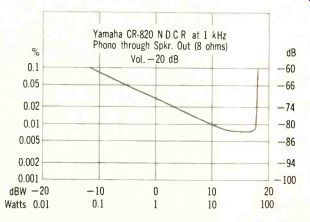
A New Look at the Numbers
Concurrent with the introduction of its new receiver line, Yamaha has promulgated a new specification--or, rather, a new way of relating several conventional specifications.
The noise/distortion clearance range (NDCR), as the new parameter is called, is applicable chiefly to receivers and integrated amps (it could be applied as well to preamp/ power amp combinations) and defines performance with respect to the combined effects of noise and distortion from a phono input right through the unit to the loud speaker terminals.
This is in contrast to the more usual practice of giving the noise and distortion specs separately for the various sections of a single piece of equipment, leaving the customer to interpret the data--if he can. To our way of thinking, it is a welcome move away from numbers games and toward disclosure of meaningful information.
To take a practical example, the CR-820 receiver re viewed in the test report section of this issue has a rated NDCR of-10 dBW (100 milliwatts) to 17 dBW (50 watts) for a combined noise and distortion of 0.1%(-60 dB) with an 8-ohm load, using a 1-kHz sine-wave test signal with the volume control set at-20 dB. Thus, if the volume control is set for a normal listening level, as specified, the test signal at the output is at least 60 dB above all noise and distortion if its power level lies between 100 milliwatts and 50 watts-a 27-dB range, as the dBW conversion demonstrates. (Our standard tests do not go to power levels low enough to confirm this claim for the CR-820, but as far as they go, none of our measured data contradict it. In addition, Yamaha uses A-weighted noise measurements, and we do not.) Anyone familiar with the "quieting" spec for FM tuners will see that the NDCR, insofar as it attempts to combine the effects of noise and distortion, is similar. It is not surprising, therefore, that it shares some of the same virtues and vices. We have already examined some of the virtues; the principal vice is that noise and distortion are not equally annoying to a listener. Given the choice of hearing music with noise at-40 dB and distortion at-60 or vice versa, we would almost certainly prefer the latter, since distortion, unless gross, is far more easily masked by a signal than is noise.
In penalizing distortion as severely as noise, the NDCR clearly reflects the philosophy of a company committed to extremely low distortion in its electronics, something that in itself can hardly be criticized. What is problematic, how ever, is that some competing products could look much worse when judged by this standard than they in fact sound.
We commend Yamaha for taking this step, but we feel constrained to point out that it is only a first step. More psychoacoustic research is needed if adequate weightings of noise and distortion are to be formulated. When a high fidelity manufacturer can offer to his prospective customer not just a great signal-to-noise ratio or vanishingly low distortion, but a clearly understandable promise of a certain degree of freedom from audible encumbrance to his music, an important milestone will have been reached.
A New Disc "De-popper"
Among the new products that we saw at the Winter Consumer Electronics Show, one struck us as highly unusual and of particular interest. That was the SAE 5000 Impulse Noise Reduction System, a device designed primarily to re move the clicks and pops that so often plague phonograph records--even new ones. Shortly before press-time, we got our hands on one of these units for a quick trial and were so impressed with its performance that we could not re strain our impulse to tell our readers something about it.
In our admittedly limited experience, the SAE 5000 does a beautiful job of removing noise impulses from discs that are in otherwise reasonably good condition. Using the sys tem in this way, you almost forget that it is connected, for the remnants of the disturbances are small enough to pass virtually unnoticed. When the unit acts repeatedly in a short period of time, the result is less successful and the "patches" become collectively audible. Actually, an analogy between this noise-suppression system and "invisible mending" is not really farfetched: If the garment looks like Swiss cheese to begin with, some of the repairs are bound to show. But over-all, the SAE 5000 has addressed itself with remarkable success to a difficult problem for the surprisingly low retail price of $200. We'll have more de tails about the device in our July article on noise reduction.
Shilkret Receives ASCAP Kudos
Nathaniel Shilkret. a composer and conductor remembered by many as a pioneer recording-studio conductor, was awarded a plaque by ASCAP (American Society of Composers, Authors, and Publishers) on the fiftieth anniversary of his election to the society, January 27, 1927.
Shilkret, who was born on December 25, 1895, was a child prodigy on the clarinet, and his association with orchestras started at the age of six when he began touring. By the end of adolescence he had played with the New York Philharmonic, the orchestra of the Metropolitan Opera, the New York Symphony, and the Sousa and Goldman symphonic bands. By the age of twenty-one, he was musical director for the Victor Talking Machine Company, and he directed many national broadcasts before moving to Hollywood in 1935 to devote his attention to motion-picture scores. [A reissue, on Victrola AVM 1.1740, of the 1929 performance of Gershwin's American in Paris in which he conducted the RCA Victor Symphony Orchestra was reviewed in our December 1976 issue.] In announcing the award, ASCAP president Stanley Adams spoke of Shilkret's "lasting contributions to American music."
(High Fidelity, May. 1977)
Also see: